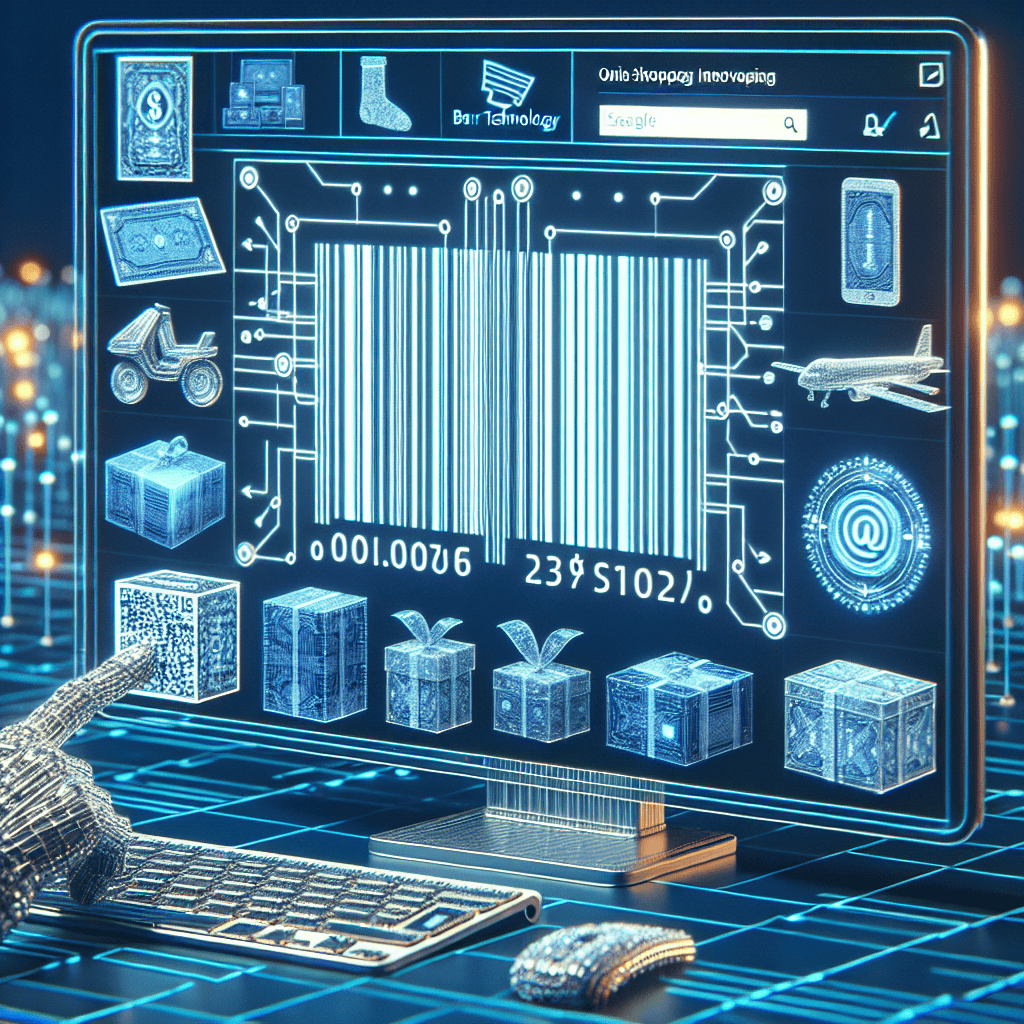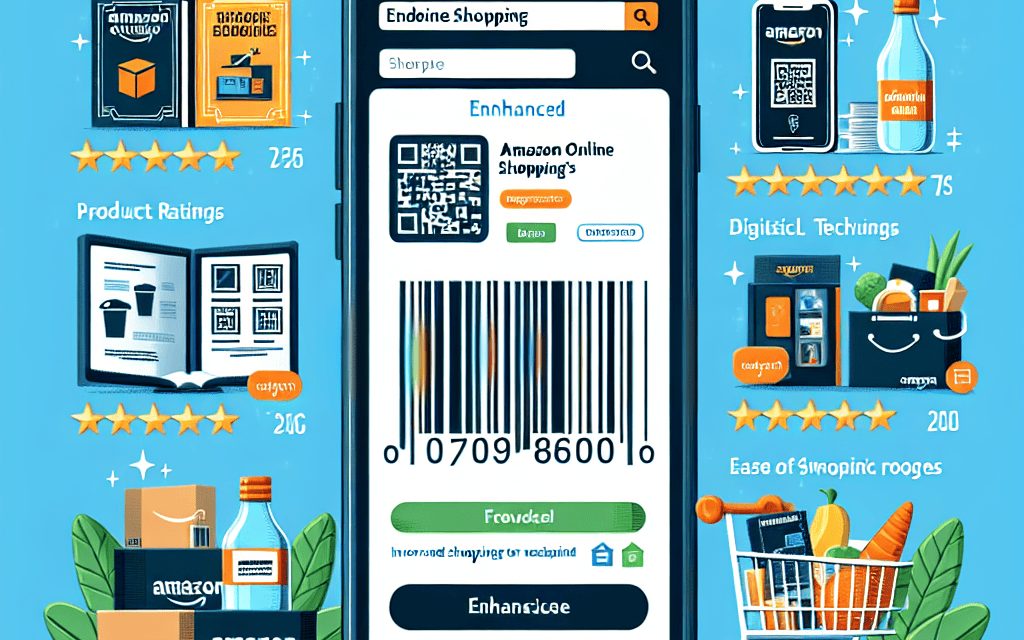“Scan, Shop, Smile: Amazon’s Barcode Revolution Transforms Your Online Experience!”
Introduction
Amazon has consistently been at the forefront of innovation in the e-commerce industry, and its latest advancement in barcode technology is set to revolutionize the online shopping experience. By integrating cutting-edge barcode solutions, Amazon aims to streamline the purchasing process, enhance inventory management, and improve overall customer satisfaction. This new technology allows for more efficient tracking and identification of products, reducing errors and ensuring faster delivery times. As a result, both consumers and sellers stand to benefit from a more seamless and reliable shopping experience, solidifying Amazon’s position as a leader in the digital marketplace.
Revolutionizing Retail: How Amazon’s New Barcode Technology Transforms Online Shopping
Amazon has long been at the forefront of innovation in the retail sector, consistently pushing the boundaries of what is possible in online shopping. The introduction of its new barcode technology marks yet another significant advancement in this domain, promising to revolutionize the way consumers interact with products online. This cutting-edge technology is designed to enhance the shopping experience by providing more detailed product information, improving inventory management, and streamlining the purchasing process.
At the heart of this innovation is Amazon’s commitment to improving the accuracy and efficiency of product identification. Traditional barcodes, while effective, have limitations in the amount of data they can store. Amazon’s new barcode technology, however, utilizes advanced data encoding techniques that allow for a more comprehensive representation of product information. This means that consumers can access a wealth of details about a product with a simple scan, including its origin, manufacturing process, and even sustainability credentials. Consequently, this empowers consumers to make more informed purchasing decisions, aligning with the growing demand for transparency in the retail industry.
Moreover, the implementation of this technology is set to transform inventory management for both Amazon and its sellers. By providing real-time data on product availability and location, the new barcodes facilitate more efficient stock management. This not only reduces the likelihood of stockouts and overstock situations but also enables faster and more accurate order fulfillment. As a result, customers can expect quicker delivery times and a more reliable shopping experience, further solidifying Amazon’s reputation for exceptional service.
In addition to enhancing inventory management, Amazon’s new barcode technology also streamlines the purchasing process. By integrating seamlessly with Amazon’s existing systems, the technology allows for faster checkout experiences. Shoppers can simply scan a product’s barcode using their smartphone or other devices, instantly adding the item to their cart and proceeding to payment. This eliminates the need for manual entry of product details, reducing the potential for errors and making the shopping process more convenient and efficient.
Furthermore, this technological advancement is poised to benefit sellers on Amazon’s platform. With more detailed product information readily available, sellers can better understand consumer preferences and tailor their offerings accordingly. This data-driven approach enables sellers to optimize their inventory, pricing strategies, and marketing efforts, ultimately driving sales and enhancing customer satisfaction. Additionally, the improved accuracy in product identification helps reduce the incidence of counterfeit goods, protecting both consumers and legitimate sellers.
As Amazon continues to refine and expand its new barcode technology, the implications for the broader retail industry are profound. Other retailers may be inspired to adopt similar innovations, leading to a more interconnected and efficient global supply chain. This could result in a more competitive marketplace, where consumers benefit from improved product offerings and enhanced shopping experiences.
In conclusion, Amazon’s new barcode technology represents a significant leap forward in the evolution of online shopping. By providing more detailed product information, improving inventory management, and streamlining the purchasing process, this innovation enhances the overall shopping experience for consumers and sellers alike. As the retail landscape continues to evolve, Amazon’s commitment to technological advancement ensures that it remains at the forefront of this dynamic industry, setting new standards for excellence and innovation.
The Future of E-commerce: Amazon’s Innovative Barcode Technology Explained
In the ever-evolving landscape of e-commerce, Amazon continues to set the pace with its latest innovation: advanced barcode technology designed to enhance the online shopping experience. This development marks a significant step forward in the integration of technology and retail, promising to streamline operations and improve customer satisfaction. As the world’s largest online retailer, Amazon’s adoption of this cutting-edge technology is poised to influence the broader industry, setting new standards for efficiency and accuracy.
At the heart of this innovation is a sophisticated barcode system that leverages machine learning and artificial intelligence to optimize inventory management and order fulfillment. Traditional barcodes, while effective, have limitations in terms of the amount of information they can convey. Amazon’s new system, however, utilizes a more complex coding structure that can store a wealth of data about each product. This includes not only basic information such as price and description but also more detailed attributes like manufacturing date, batch number, and even environmental impact data. By embedding this comprehensive information directly into the barcode, Amazon can ensure that every product is tracked with unparalleled precision from the warehouse to the customer’s doorstep.
Moreover, this technology enhances the accuracy of Amazon’s supply chain operations. With the ability to access detailed product information instantly, warehouse staff can reduce errors in picking and packing, leading to faster and more reliable deliveries. This is particularly crucial during peak shopping periods, such as the holiday season, when the volume of orders can overwhelm traditional systems. By minimizing human error and automating key processes, Amazon’s barcode technology not only boosts efficiency but also reduces operational costs, savings that can potentially be passed on to consumers.
In addition to improving internal operations, Amazon’s new barcode technology offers significant benefits to customers. One of the most notable advantages is the potential for enhanced product transparency. Shoppers can access detailed information about a product’s origin, materials, and sustainability credentials simply by scanning the barcode with their smartphone. This aligns with the growing consumer demand for transparency and ethical sourcing, empowering customers to make informed purchasing decisions. Furthermore, the technology facilitates a more personalized shopping experience. By analyzing the data embedded in barcodes, Amazon can tailor recommendations and promotions to individual preferences, enhancing customer engagement and satisfaction.
The implementation of this advanced barcode system also underscores Amazon’s commitment to sustainability. By optimizing inventory management and reducing waste, the company can minimize its environmental footprint. For instance, more accurate tracking of perishable goods can lead to a reduction in spoilage, while efficient packaging processes can decrease the use of excess materials. These efforts are in line with Amazon’s broader sustainability goals and reflect a growing recognition of the importance of environmentally responsible business practices.
As Amazon continues to refine and expand its use of this innovative barcode technology, the implications for the e-commerce industry are profound. Competitors may be compelled to adopt similar systems to remain competitive, potentially leading to widespread improvements in efficiency and customer service across the sector. In conclusion, Amazon’s new barcode technology represents a significant advancement in the future of e-commerce, offering a glimpse into a more efficient, transparent, and sustainable shopping experience. As this technology becomes more prevalent, it is likely to redefine consumer expectations and set new benchmarks for the industry as a whole.
Enhancing Customer Experience: The Impact of Amazon’s Barcode Technology on Online Shopping
Amazon has long been at the forefront of innovation in the e-commerce industry, consistently seeking ways to enhance the customer experience. Recently, the company has introduced a new barcode technology that promises to revolutionize online shopping. This advancement is not merely a technical upgrade but a strategic move to streamline operations, improve accuracy, and ultimately provide a more seamless shopping experience for consumers. As we delve into the implications of this technology, it becomes evident that Amazon’s latest initiative is set to redefine the standards of online retail.
To begin with, the new barcode technology is designed to enhance the efficiency of Amazon’s vast logistics network. By implementing a more sophisticated system, Amazon can ensure that products are tracked with greater precision from the moment they enter the warehouse until they reach the customer’s doorstep. This level of accuracy minimizes the risk of errors, such as incorrect shipments or misplaced items, which have been occasional pain points for online shoppers. Consequently, customers can expect a higher level of reliability and trust in their online purchases, knowing that the likelihood of receiving the wrong item is significantly reduced.
Moreover, this technology facilitates faster processing times within Amazon’s fulfillment centers. By automating various aspects of inventory management and order processing, the company can expedite the movement of goods through its supply chain. This efficiency translates into quicker delivery times, a critical factor in customer satisfaction. In an era where consumers increasingly demand instant gratification, Amazon’s ability to shorten delivery windows gives it a competitive edge over other retailers. As a result, customers are more likely to choose Amazon for their online shopping needs, knowing that their orders will arrive promptly.
In addition to operational benefits, the new barcode technology also enhances the customer experience by providing more detailed product information. When customers scan a barcode using their smartphones, they can access a wealth of information about the product, including specifications, reviews, and even personalized recommendations based on their shopping history. This feature empowers consumers to make more informed purchasing decisions, thereby increasing their confidence in the products they choose. Furthermore, it fosters a more interactive and engaging shopping experience, as customers can explore related items and discover new products that align with their preferences.
Another significant impact of this technology is its potential to reduce waste and promote sustainability. By improving inventory accuracy and reducing errors, Amazon can minimize the number of returns and exchanges, which often contribute to environmental waste. Additionally, the technology enables more efficient packaging processes, ensuring that products are shipped in appropriately sized boxes, thereby reducing excess packaging materials. This commitment to sustainability resonates with environmentally conscious consumers, who are increasingly prioritizing eco-friendly practices in their purchasing decisions.
In conclusion, Amazon’s new barcode technology represents a pivotal advancement in the realm of online shopping. By enhancing operational efficiency, improving delivery times, and providing richer product information, this innovation significantly elevates the customer experience. Moreover, its potential to promote sustainability aligns with the growing demand for environmentally responsible practices. As Amazon continues to refine and expand this technology, it is poised to set new benchmarks for the e-commerce industry, further solidifying its position as a leader in the digital marketplace. Through these efforts, Amazon not only meets the evolving expectations of consumers but also shapes the future of online retail.
Streamlining Supply Chains: Amazon’s Barcode Technology and Its Benefits for Retailers

Amazon has long been at the forefront of innovation in the retail sector, consistently seeking ways to enhance the shopping experience for both consumers and retailers. In its latest endeavor, Amazon has introduced a new barcode technology designed to streamline supply chains and improve operational efficiency. This advancement promises to bring significant benefits to retailers, offering a more seamless and efficient approach to inventory management and product tracking.
The introduction of this new barcode technology is a testament to Amazon’s commitment to leveraging cutting-edge solutions to address the complexities of modern supply chains. Traditional barcodes, while effective, have limitations in terms of the amount of information they can convey. Amazon’s enhanced barcodes, however, are designed to carry more detailed data, allowing for a more comprehensive understanding of each product’s journey from manufacturer to consumer. This increased data capacity enables retailers to track products with greater precision, thereby reducing errors and improving inventory accuracy.
Moreover, the new barcode technology facilitates real-time data sharing across the supply chain. This capability is particularly beneficial for retailers, as it allows them to respond more swiftly to changes in demand and supply. For instance, if a particular product is selling faster than anticipated, retailers can quickly adjust their orders to prevent stockouts. Conversely, if a product is not performing as expected, they can scale back orders to avoid overstocking. This level of agility is crucial in today’s fast-paced retail environment, where consumer preferences can shift rapidly.
In addition to improving inventory management, Amazon’s barcode technology also enhances the overall customer experience. With more accurate tracking information, retailers can provide customers with precise delivery estimates and updates, thereby increasing transparency and trust. Furthermore, the technology supports more efficient returns processing, as products can be tracked more accurately throughout the return journey. This improvement not only benefits consumers but also helps retailers manage their reverse logistics more effectively.
Another significant advantage of Amazon’s new barcode technology is its potential to reduce costs for retailers. By minimizing errors in inventory management and streamlining operations, retailers can achieve greater efficiency and reduce waste. This cost-saving potential is particularly appealing in an industry where margins are often tight. Additionally, the technology’s ability to provide detailed insights into consumer behavior and product performance can inform more strategic decision-making, further enhancing profitability.
As retailers increasingly adopt Amazon’s barcode technology, the broader implications for the retail industry become apparent. The enhanced data capabilities and improved supply chain visibility can lead to more sustainable practices, as retailers can better manage resources and reduce excess inventory. This shift towards sustainability is not only beneficial for the environment but also aligns with the growing consumer demand for more responsible business practices.
In conclusion, Amazon’s new barcode technology represents a significant advancement in the realm of supply chain management. By offering enhanced data capabilities, real-time tracking, and improved operational efficiency, this innovation provides substantial benefits for retailers. As the retail landscape continues to evolve, technologies like these will play a crucial role in helping businesses adapt and thrive. Through its commitment to innovation, Amazon is once again setting a new standard for the industry, paving the way for a more efficient and sustainable future in retail.
A New Era of Shopping: The Role of Barcode Technology in Amazon’s E-commerce Strategy
Amazon has long been at the forefront of innovation in the e-commerce industry, consistently seeking ways to enhance the shopping experience for its vast customer base. In its latest endeavor, the retail giant has introduced a new barcode technology that promises to revolutionize the way consumers interact with online shopping platforms. This development is not merely a technological upgrade but a strategic move that underscores Amazon’s commitment to maintaining its competitive edge in the rapidly evolving digital marketplace.
The introduction of advanced barcode technology is set to streamline the shopping process, making it more efficient and user-friendly. By integrating this technology into its platform, Amazon aims to simplify product identification and inventory management, thereby reducing the likelihood of errors and improving overall customer satisfaction. This is particularly significant in an era where consumers demand speed and accuracy in their online shopping experiences. The new barcode system allows for quicker scanning and processing of products, which translates to faster delivery times and enhanced service reliability.
Moreover, this technological advancement is poised to benefit not only consumers but also sellers on the Amazon platform. For sellers, the new barcode technology offers a more precise method of tracking inventory, which is crucial for maintaining optimal stock levels and preventing overstock or stockouts. This level of precision in inventory management can lead to significant cost savings and increased profitability for businesses. Additionally, the enhanced tracking capabilities provide sellers with valuable insights into consumer purchasing patterns, enabling them to tailor their offerings to better meet customer demands.
Transitioning from the benefits to consumers and sellers, it is important to consider the broader implications of this technology on the e-commerce landscape. As Amazon continues to innovate, it sets a benchmark for other players in the industry, compelling them to adopt similar technologies to remain competitive. This ripple effect can lead to widespread improvements in the e-commerce sector, ultimately benefiting consumers through improved service standards and more diverse product offerings.
Furthermore, the implementation of this new barcode technology aligns with Amazon’s sustainability goals. By optimizing inventory management and reducing errors, the company can minimize waste and improve resource efficiency. This is a crucial consideration in today’s environmentally conscious market, where consumers are increasingly prioritizing sustainability in their purchasing decisions. Amazon’s commitment to integrating sustainable practices into its operations not only enhances its brand image but also contributes to a more sustainable future for the retail industry as a whole.
In addition to its immediate benefits, the new barcode technology lays the groundwork for future innovations in e-commerce. As technology continues to evolve, there is potential for further enhancements that could include augmented reality shopping experiences, personalized recommendations based on real-time data, and even more sophisticated supply chain management systems. By investing in cutting-edge technology today, Amazon is positioning itself to capitalize on these future opportunities, ensuring its continued leadership in the e-commerce space.
In conclusion, Amazon’s introduction of new barcode technology marks a significant milestone in its e-commerce strategy. By enhancing the efficiency and accuracy of the shopping experience, the company is not only meeting the current demands of consumers and sellers but also setting the stage for future advancements. As the e-commerce landscape continues to evolve, Amazon’s commitment to innovation and sustainability will undoubtedly play a pivotal role in shaping the future of online shopping.
From Warehouse to Doorstep: How Amazon’s Barcode Technology Improves Delivery Efficiency
Amazon has long been at the forefront of innovation in the e-commerce industry, consistently seeking ways to enhance the customer experience and streamline its operations. The introduction of new barcode technology is the latest advancement in Amazon’s ongoing efforts to improve delivery efficiency from warehouse to doorstep. This cutting-edge technology promises to revolutionize the way products are tracked and delivered, ensuring that customers receive their orders more quickly and accurately than ever before.
At the heart of this technological advancement is the implementation of advanced barcode systems that allow for more precise tracking of items throughout the supply chain. Traditional barcodes, while effective, have limitations in terms of the amount of information they can convey. Amazon’s new system utilizes two-dimensional barcodes, which can store significantly more data. This increased data capacity enables Amazon to encode detailed information about each product, including its origin, destination, and specific handling instructions. As a result, the entire logistics process becomes more transparent and efficient.
Moreover, the integration of this new barcode technology with Amazon’s existing infrastructure allows for seamless communication between various stages of the delivery process. From the moment a product is picked in the warehouse, the enhanced barcode provides real-time updates to Amazon’s logistics network. This ensures that every item is accounted for and that any potential issues can be identified and addressed promptly. Consequently, the likelihood of errors, such as misplaced or delayed packages, is significantly reduced.
In addition to improving accuracy, the new barcode technology also enhances the speed of the delivery process. By automating many of the tasks traditionally performed by human workers, such as scanning and sorting packages, Amazon can expedite the movement of goods through its distribution centers. This automation not only reduces the time it takes for an order to be processed but also allows Amazon to handle a higher volume of packages, particularly during peak shopping periods. As a result, customers can expect faster delivery times, even during the busiest seasons.
Furthermore, the implementation of this technology aligns with Amazon’s commitment to sustainability. By optimizing the logistics process, Amazon can reduce the number of resources required to deliver each package. For instance, more efficient routing and sorting can lead to fewer delivery vehicles on the road, thereby decreasing carbon emissions. Additionally, the reduction in errors and delays means that fewer resources are wasted on re-shipping or correcting mistakes. This focus on sustainability not only benefits the environment but also enhances Amazon’s reputation as a socially responsible company.
The introduction of new barcode technology is a testament to Amazon’s dedication to continuous improvement and innovation. By leveraging advanced data capabilities and automation, Amazon is able to provide a more efficient and reliable delivery service to its customers. As the e-commerce landscape continues to evolve, such technological advancements will be crucial in maintaining Amazon’s position as a leader in the industry. Ultimately, this new barcode system represents a significant step forward in Amazon’s mission to deliver a seamless and satisfying shopping experience from warehouse to doorstep.
The Tech Behind the Cart: Understanding Amazon’s Advanced Barcode System in Online Shopping
Amazon has long been at the forefront of innovation in the e-commerce industry, consistently seeking ways to enhance the online shopping experience for its vast customer base. Recently, the company has introduced a new barcode technology that promises to revolutionize the way consumers interact with products online. This advanced system is designed to streamline the shopping process, improve inventory management, and provide a more personalized shopping experience.
At the heart of this technological advancement is the integration of sophisticated barcode scanning capabilities that go beyond traditional uses. While barcodes have been a staple in retail for decades, primarily used for tracking inventory and facilitating checkout processes, Amazon’s new system leverages these codes to offer a more interactive and informative shopping journey. By scanning a product’s barcode with a smartphone or other device, customers can instantly access a wealth of information about the item, including detailed specifications, customer reviews, and even personalized recommendations based on their shopping history.
Moreover, this technology enhances the accuracy and efficiency of Amazon’s inventory management. By employing advanced algorithms and real-time data analytics, the system ensures that stock levels are constantly updated, reducing the likelihood of errors that can lead to overstocking or stockouts. This not only benefits Amazon by optimizing its supply chain operations but also ensures that customers have access to the products they desire without unnecessary delays.
In addition to improving inventory management, the new barcode technology also plays a crucial role in enhancing the security and authenticity of products sold on Amazon’s platform. Counterfeit goods have long been a challenge for online retailers, but with this advanced system, each product can be traced back to its origin, ensuring that customers receive genuine items. This is achieved through a combination of unique identifiers embedded within the barcodes and blockchain technology, which provides a secure and immutable record of a product’s journey from manufacturer to consumer.
Furthermore, Amazon’s barcode technology is designed to integrate seamlessly with its existing artificial intelligence and machine learning systems. This integration allows for a more personalized shopping experience, as the system can analyze a customer’s past purchases and browsing behavior to suggest products that align with their preferences. This level of personalization not only enhances customer satisfaction but also increases the likelihood of repeat purchases, thereby boosting Amazon’s overall sales.
As Amazon continues to refine and expand its barcode technology, the potential applications are vast. For instance, the company is exploring ways to incorporate augmented reality features that would allow customers to visualize how a product might look in their home before making a purchase. This could be particularly beneficial for items such as furniture or home decor, where seeing the product in context can significantly influence buying decisions.
In conclusion, Amazon’s new barcode technology represents a significant leap forward in the realm of online shopping. By enhancing the accuracy of inventory management, ensuring product authenticity, and providing a more personalized shopping experience, this system is poised to set a new standard for e-commerce platforms worldwide. As the technology continues to evolve, it will undoubtedly play a pivotal role in shaping the future of online retail, offering consumers an even more seamless and engaging shopping experience.
Q&A
1. **What is the new barcode technology introduced by Amazon?**
Amazon has introduced a new barcode technology called “Amazon One” that uses palm recognition for payment and identification purposes.
2. **How does the new barcode technology work?**
The technology scans a user’s palm to identify them and link their payment information, allowing for a seamless and contactless shopping experience.
3. **What are the benefits of Amazon’s new barcode technology?**
The benefits include faster checkout times, enhanced security through biometric data, and a more convenient shopping experience without the need for physical cards or cash.
4. **Where is Amazon implementing this new technology?**
Amazon is implementing this technology in its physical retail locations, such as Amazon Go stores, and plans to expand its use to other retail partners.
5. **How does Amazon ensure the security of the biometric data?**
Amazon ensures security by encrypting the biometric data and storing it securely in the cloud, with strict access controls and privacy measures in place.
6. **What impact does this technology have on traditional barcodes?**
While traditional barcodes are still in use, this technology offers an alternative that could reduce reliance on physical barcodes and streamline the shopping process.
7. **Are there any privacy concerns associated with Amazon’s new technology?**
Some privacy concerns exist regarding the collection and storage of biometric data, but Amazon addresses these by providing transparency and allowing users to manage their data preferences.
Conclusion
Amazon’s introduction of new barcode technology significantly enhances the online shopping experience by streamlining the checkout process, improving inventory management, and increasing accuracy in order fulfillment. This innovation not only reduces errors and inefficiencies but also provides customers with faster and more reliable service. By integrating advanced barcode systems, Amazon strengthens its logistical capabilities, ensuring that it remains at the forefront of e-commerce innovation and customer satisfaction. This strategic move underscores Amazon’s commitment to leveraging technology to optimize operations and deliver superior shopping experiences.





